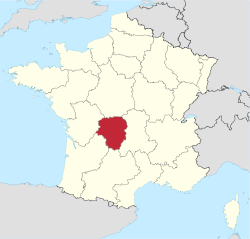|
Limousin
Limousin (French pronunciation: [limuzɛ̃] ⓘ; Occitan: Lemosin [lemuˈzi]) is a former administrative region of southwest-central France. On 1 January 2016, it became part of the new administrative region of Nouvelle-Aquitaine.[3] It comprised three departments: Corrèze, Creuse, and Haute-Vienne. Situated mostly in the west side of south-central French Massif Central, Limousin had (in 2010) 742,770 inhabitants[1] spread out on nearly 17,000 km2 (6,600 square miles), making it the least populated region of metropolitan France. Forming part of the southwest of the country, Limousin was bordered by the regions of Centre-Val de Loire to the north, Auvergne to the east, Midi-Pyrénées to the south, Aquitaine to the southwest, and Poitou-Charentes to the west. Limousin was also part of the larger historical Occitania region. PopulationThe population of Limousin was aging and, until 1999, was declining. The department of Creuse had the oldest population of any in France. Between 1999 and 2004 the population of Limousin increased slightly, reversing a decline for the first time in decades.[4] Major communities  HistoryLimousin was one of the traditional provinces of France. Its name derived from that of a Celtic tribe, the Lemovices, who had their capital at Saint-Denis-des-Murs and whose main sanctuary in 2004 was found in Tintignac, a site which became a major site for Celtic studies thanks to unique objects which were found – such as the carnyces, unique in the whole Celtic world.[5] Viscount Aimar V of Limoges (c. 1135 – c. 1199) was a notable ruler of the region. LanguageUntil the 1970s, Occitan was the primary language of rural areas. There remained several different Occitan dialects in use in Limousin, although their use was rapidly declining. These were:
Transport
Notable residentsFrom CorrèzeFrom CreuseFrom Haute-VienneSee also
Footnotes
External links
|
||||||||||||||||||||||||||||||||||||||||||||||||||


